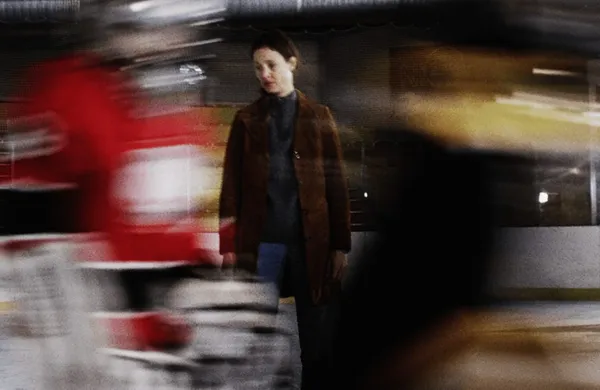 |
| Mathieu Amalric on the coat worn by Shirley Knight in Francis Ford Coppola’s The Rain People and the one on Vicky Krieps: “That’s the reference. I told that to Caroline Spieth, the costume person.” |
Mathieu Amalric’s terrific Hold Me Tight (Serre Moi Fort), based on the play Je Reviens De Loin by Claudine Galéa, shot by Christophe Beaucarne (Amalric’s Barbara and The Blue Room; Benoît Jacquot’s Suzanna Andler, based on a Marguerite Duras play; Nicole Garcia’s Lovers and From The Land Of The Moon; Etienne Comar’s Django with Reda Kateb as Django Reinhardt) and starring Vicky Krieps and Arieh Worthalter was a highlight of the 74th Cannes Film Festival and New York’s 27th edition of Rendez-Vous with French Cinema. In the first instalment with Mathieu we discussed his films on John Zorn, thoughts on Robert Musil, Thomas Bernhard, Jerry Lewis, and going to Rome to film with Nanni Moretti Il Sol Dell'avvenire.
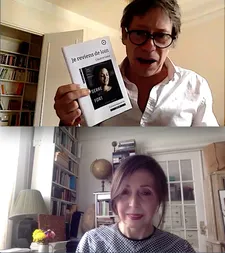 |
| Mathieu Amalric (Je Reviens De Loin by Claudine Galéa) with Anne-Katrin Titze on Vicky Krieps as Clarisse: “As you said, she does the film. Her character is the projectionist, is the editor in fact.” |
Hold Me Tight begins brilliantly with a woman, Clarisse (Krieps), turning over polaroids of her family life displayed on a table in a kind of makeshift memory game. We hear slapping noises. What happens when you try to take control of the narrative of your life is one of the many puzzle questions the film raises.
“I’m sick of being little,” says one of her two children. Daughter Lucie (Juliette Benveniste) wants a piano, son Paul (Aurèle Grzesik) wants a treehouse. What could her husband Marc (Worthalter) want?
The movie is tinged in shades of coral - from the tablecloth to Clarisse’s fluffy sweater, to the rust and the car. You could also call it the colours of blood, depending on how much water has been mixed in. Clarisse talks to a girlfriend (Aurélia Petit) at a gas station. It was cold and early in the morning when she drove off. At home, her family does family things and Lucie wears her mother’s dressing gown. On the fridge is the shopping list: bread, wine, cheese, eggs, artichokes.
A woman in a bar has drinks. For a second I did not recognize her as Clarissa. She is elsewhere and explains in German in a harbour a boat and a rope to a group of tourists. She scolds a father (Sylvain Micard) about how he treats his kid (Siméon Micard). In a marvellous feat of cross-cutting, we see her husband Marc getting rid of her stuff on the bathroom shelves.
Clarisse puts her head in the fish ice at the market and collapses while her son screams at home “You threw away mom! You threw her perfume away!” With the woman alone in her new life and the family without her, past and present are not what they seem. The house was built in 1722 and the car is from 1978, but grief, pain, and invention are not so easy to pin down as they hold us tight. We all live with ghosts and those who leave may not have left at all.
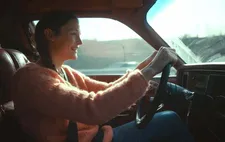 |
| Mathieu Amalric on Vicky Krieps as Clarisse: “I wanted her to be in action all the time.” |
From Paris, Mathieu Amalric joined me on Zoom for an in-depth wide-ranging exploration of his cultural interests and Hold Me Tight.
Anne-Katrin Titze: With Hold Me Tight you are really taking risks, aren’t you? A big wow for storytelling!
Mathieu Amalric: If there is a risk, Claudine [Galéa, who wrote the never-performed play, Je Reviens De Loin, on which the film is based] is the one who took it by inventing this trick for the imagination of the character, let’s say. This so simple thing, to say, what about if I tell to myself I’m the one who left.
The reverse then means that they stayed. Then she can make them grow, make them live in her head. I didn’t think of risks. For me it was maybe something with cinema that can welcome this trick, very simple illusion that we all use in difficult moments.
AKT: It’s the idea of taking control of the narrative. We’re back to Freud, to the fort/da game. As in, I put a blanket over my head and I’m gone. It’s all about control in situations that are totally out of control.
MA: Wow, it’s exactly that. I haven’t thought of it, but it’s exactly that. It makes me think of children who go and say “Tu est mort!” You are dead! And it’s true that with Vicky very quickly we had this pulsing of humour, that Clarisse would have a sort of pleasure, humour in her imagination.
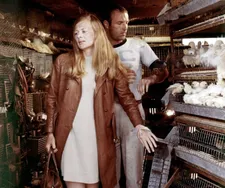 |
| Shirley Knight (in the coat) with James Caan in Francis Ford Coppola’s The Rain People |
The audience could guess of her despair. I wrote it but I knew I wasn’t going to film it, the month she spent in that house after the accident. Her friend from the gas station that told her “you can’t stay in that house, you have to go away now. I don’t know, go to the sea!” “Okay, I don’t care about the sea. I’ll see.” Those things, we didn’t need to film them. It was what you say, this game.
AKT: Apropos, I loved the idea of the memory game that you start the film with, using polaroids. Is that in the book or your invention?
MA: It wasn’t in the book, but it happened because the first thing we had to do was to take photos of the past of this family in the house. So the four of them, the real children, the little ones, Arieh and Vicky, lived in the house for two days and I gave them a little [disposable] camera. I would also take a camera. I had invented situations, a birthday, a breakfast, normal things like that.
Then Christophe Beaucarne, the DoP, he had a polaroid, an old polaroid that he always had; he always takes those. Then he would put them on a table outside in the garden. And after a moment all these photos were displayed and when I saw them it recalled this memory game that in fact I had as a child in the States. From five to eight, as you know, I lived in Washington. And so it reminded me of this memory game that I still have.
AKT: Oh really?
MA: Yes, and we even filmed this memory game in scenes that I took out from the film when there was a sort of moment where Clarisse would fall into craziness. We filmed the scene in a hospital where she was playing with the memory game. And there was the blue star [Mathieu gestures to his eye]. That’s why you then see the blue star on the boy’s face.
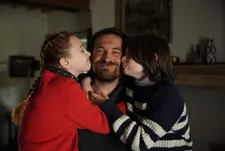 |
| Lucie (Juliette Benveniste) and Paul (Aurèle Grzesik) with their father Marc (Arieh Worthalter) |
There were signs everywhere and the objects. That’s the first thing I did; I took the book and made a list of all the objects that were in this play, that is not written like a play. [Mathieu holds it up for me to see]. It’s A, B, C, D or it can be poems, just poems. Or it could also be different languages that are in super-imposition, in bold or italics. It plays like things that are in her head. I was inspired. It was never performed, never. [Mathieu lights a cigarette] Sorry, I’ve got to smoke.
AKT: Don’t be sorry, you’re at home. I mean, people are in their cars driving through Rome while I’m interviewing them. So feel free. I also loved the memory game when I was little, so you captured my attention from the start. When she puts the papers in the lining of her coat, was that a little hint at Phantom Thread?
MA: Maybe unconsciously! But not in the moment. It’s moments that I would invent like that. My job was to give to Vicky lots of gestures, things that she could do and not be only in a state. I wanted her to be in action all the time. That came along and it was more about my grandmother, my Jewish grandmother, you know. Maybe it’s something very natural. I remember stories like that.
And I had read something recently on Robert Musil’s wife. When they found her coat there was a letter by her husband Robert in the coat. It’s often that sort of stories. And I thought about that; sometimes I was thinking of very dark things. Maybe she is preparing for a suicide. Maybe she’ll want to throw herself from a cliff, thinking, if they find me, they maybe find that. Things in those terrible moments, that can not only be the tragedy from a loss like that, but can also be a love rupture. When you split, it’s so violent.
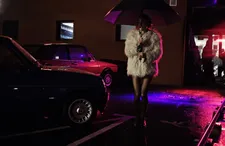 |
| Mathieu Amalric on Vicky Krieps’s Clarisse in the flashback: “Vicky came with this sort of white like snow snowy coat.” |
AKT: And to put a message inside clothing, inside garments we use to protect ourselves! I did a feature with Sarah Noa Bozenhardt, the director who made a documentary on women giving birth in Ethiopia, called Among Us Women. And we talked about fabric and the ideas of cover and protecting ourselves. Then there are the messages we send with what we wear. All of that is in this coat.
MA: Yes, and the coat is exactly that! It’s like she put that with the pink sweater to protect herself. It’s almost the same coat but not in leather, it’s the same coat that Shirley Knight has in The Rain People. That’s the reference. I told that to Caroline Spieth, the costume person. You see she had that long leather coat almost the same colour.
AKT: Leather is an animal skin. You are in pain or in hiding, I am thinking of Peau d'Âne, for instance. The animal kingdom gives respite in an attempt to get away from humanity which is so cruel.
MA: Yes! Of course it didn’t go through words. I told her about that coat. Vicky also showed me things. At the end, how she would be in sort of pyjamas that she would never wash. Not wash her hair also, that it would be protected.
Then for instance for the flashback in the discotheque when they meet each other, Vicky came with this sort of white like snow snowy coat. And I said, listen, this could be incredible. It was her own stuff. It’s feelings like that. It was always trying to put in the frame tons and tons of objects. Because as you said, she does the film. Her character is the projectionist, is the editor in fact. She is doing it and we don’t feel that immediately. She puts those objects like the Indian …
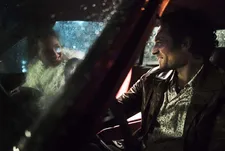 |
| Clarisse (Vicky Krieps) with Marc (Arieh Worthalter) in the flashback when they meet. |
AKT: … the dreamcatcher?
MA: Yes, there’s always objects that come back.
AKT: One of the edits I found particularly jarring and fascinating is when she puts her head in the ice, the fish ice at the market and soon after we have the boy screaming “you threw away mom! You threw her perfumes away.” Talk about objects! That edit is very powerful.
MA: Wow. The scene in the bathroom with the perfume is in Claudine’s book. That he was in white [shaving] foam, that came to mind because I’m always thinking of her with the images of the white everywhere. It’s great to have the story of someone who has the courage to leave their family. Oh we all want to do that, or imagined to do that one day.
Then yes, when I was looking at the market, I was often in the head of Clarisse. Because you have to write that with tears, you know. When I saw that in the morning and that the fish weren’t there yet when they were putting the ice. For me she was going to be attracted by that or it was going to be so overwhelming for her. Even when I saw those black signs where they put the price, for me it was tombs with names.
AKT: Oh I didn’t get that! I get it now that it’s tombstones.
MA: You feel it the second time you see the film because the first time you’re still in the story of a woman that seems to have culpability of leaving her family. That was in Claudine’s book that only really at the end you have the sort of twist. With François Gédigier, the editor, we felt what was really a nerve that was interesting was that the audience could be exactly like her, the character, in a denial. We know that it’s not her children but we prefer to forget it because it’s unbearable.
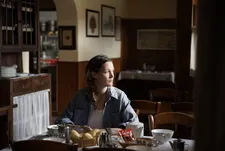 |
| Mathieu Amalric on Vicky Krieps as Clarisse: “It’s great to have the story of someone who has the courage to leave their family.” |
So it’s better to forget. And she does it so well, she does it like Robert Bechtle when he paints the car, the hyper-realism painting. She does it perfectly. So we have to believe. I was thinking of the scream when you go through a disaster and you scream “C’est pas vrai! It’s not true, it can’t be true, tell me it’s not true!” And this thing, it’s not true, just to survive.
AKT: That we need for grief, for pain, that invention and humuor that is also there with Vicky’s performance. It’s so necessary. Just looking at the world now we need something. At the very end you give us a super interesting perspective from the window. We see her walking to the car and there is a ghost. I was thinking of David Lowery’s Ghost Story, many ghost stories actually, where the ghost is watching. I felt you were playing with this throughout, which I like very much.
MA: You’re incredible. You’re such an incredible spectator. I mean, you feel things and can express it. Yes, it was exactly that. Often in the film I wanted this horrible thing of locking the audience inside the house. And the door that closes. There it was: no, no don’t leave us! We want to go with you, with your imagination. Continue the story please, not reality! Reality can’t win at the end.
We did two shots; there was this shot and then it would go to the poster of Robert Bechtle. Then I did one take without going to the Robert Bechtle painting. It wasn’t in the play that she sold the house but for me I wanted her to go back on the road, to not be in a mausoleum.
That’s what we needed with this extraordinary music played by Marcelle Meyer, this woman pianist of the Forties, Fifties, who plays Rameau with this sort of energy, that she’s going be okay. It was obvious that we had to be with her in the car to end. And not in the fright of: Don’t leave us in the house with the ghosts!
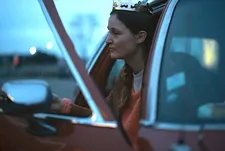 |
| Mathieu Amalric on Clarisse (Vicky Krieps) wearing the coat: “She put that with the pink sweater to protect herself.” |
AKT: The other time you were going into ghostly or not so ghostly territory with the husband’s werewolf body hair, loup garou thing. It turns quite funny when she meets this other man. Is that in the book or is that you?
MA: There is a scene where he is in the bathroom and he has a monologue. It says Marc in front of a mirror. It’s a monologue: “Did you see this hair?” And he’s talking to her. So there are words from Claudine. Then I was imagining if she wanted to see him naked she could put him naked.
Then she could imagine he was a bit older, so his hair … And he thinks he’s a bit thick. That’s why she’s laughing, we can hear her. She likes to put it in the situation that he never recovered from that she left. Even at his work he continues to talk about how his wife left. And they say “You just stop it now.” For her it’s nice to think that.
We shot in three periods, of course, because we needed the spring and we needed the snow at the mountain. So we first shot before COVID. We started in the spring, so we started with the end with the bodies. It was great. The third day of shooting Vicky had the bodies coming back. It was done. Then we could be more light. Then we shot in November 2019 and then in January 2020 the snow. We would edit between.
I would say to Vicky, “let’s forget that you lost your family, I’m sick of it. Let’s have fun.” I said “maybe you could meet men, maybe you could say bad things about the children, that they were boring and that you wanted to throw them by the window or that he was furniture, things like that. Maybe you want to have sex with a man and just pick a guy.” It was supposed to be that. She was supposed to take this guy, put him on the floor, make love to him. In the moment, it was a bit too much.
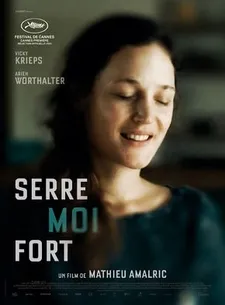 |
| Serre Moi Fort poster |
AKT: It definitely would have been.
MA: We didn’t have an actor because I invented that two or three days before. So I have to pick each time people from the crew. As Arieh has hair, I was looking at guys with hair. And Jean-Phiippe [Petit], he’s from the decoration crew, and girls just love him. He’s such a handsome and beautiful man, he’s so tender. And was going to have a baby so he was very fragile like that.
And I just showed him to Vicky and she was okay. Then we arrived at not making love on the floor, that was too much. Then we filmed something that with a pen she would draw the tattoos that Arieh had. It was a bit complicated, it wasn’t very sexy, it was [Mathieu rolls his eyes]. Then it was just this. It was the last shot.
AKT: It works.
MA: It was the last night of shooting. We finished with that. That’s why the key guy, the guy who does the light, [Victor Abadia] he’s the one who says “I like your car.” And she goes “What about me? I’m chopped liver?” We always called him Clark Gable. He always had cigars in his truck, he’s very handsome, very chic. I invented these scenes so that she could sing in the car, because Vicky has those songs in her.
AKT: The moments that are off are off because they are. It’s a hint, but not an obvious hint because the whole thing is so alive. It’s a very alive film.
MA: The hair, of course, she thinks of him. That’s why then there is this scene, the breakfast where the kids that are not her kids are. It’s a moment of normal, casual, every-day happiness that you’re not aware of but that you can’t live. To do that Vicky was in another room with a mic, she had the image, she could hear them, and only Arieh had an earplug and she could talk to him, not the kids.
There were very precise rendez-vous moments. But I knew that the film would be made with pieces, would be fragmented like her imagination. So to get the life, as you say, I would do one or two takes for 25 minutes. So that then we would have moments of life each time. Then I knew I could work with that.
Read what Mathieu Amalric had to say on John Zorn, Robert Musil, Thomas Bernhard, Jerry Lewis, and Nanni Moretti.
Hold Me Tight (Serre Moi Fort) opens at Film at Lincoln Center on Friday, September 9. Sneak Preview and Q&A on September 8 with Mathieu Amalric and Vicky Krieps.





















